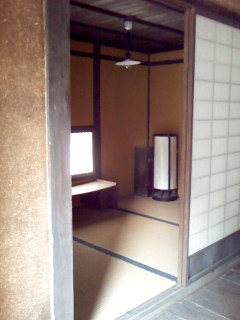Tsuwano is just the way I've always imagined. It's beautiful.
This is the main street about 10 minute-walk away from Tsuwano Station.
It rained on and off, and we even had hail.
Mori Ohgai's house where he lived growing up. He went to Tokyo with his father when he was ten. The father was one of the doctors worked for the lord of Tsuwano Han. Red colored tile roofs are a representative of Tsuwano's products.
The house is similar to the house I was growing up. As you see it, in summertime, we leave all doors open as the photo.
From Mori Ohgai's house, I crossed a bridge to get to Nishi Amane's house.
I talked about these incredibly over achievers before, and Wikipedia is available. Tsuwano Han was relatively small han, but it contributed highly to the change of the government from feudal to modern.
This is the front of Mori Ohgai's house. The square table is to be used during winter covered with a thick futon and a stove underneath.
I was a bit afraid to walk across this bridge, but I wanted to see Nishi Amane's house.
This is Nishi Amane's house.
This is the storage house in the compound.
The front of the house. It isn't much different from the house I grew up.
This is the three-tatami-mat room in the storage house where Nishi studied.
The back of the house.
This is the kitchen area.
What I love about Tsuwano is that small streams run through the city.
I heard the sound of water everywhere as I walked. I'd like to listen to it all day.
Some houses are surrounded by streams like below. Water is clear.
I wanted to buy mikan (mandarin oranges), but I couldn't because of the weight.
Too bad. Compared to the price in Yokohama, this is very inexpensive.
I was very impressed with this notice. The owner of this shop apologizes of closing the business
and says thank-you to all the customers for their long-time patronage. The construction of the sentences simple and right to the point, and the brushstrokes are also the same.
This sincerity is not easy to achieve in my opinion.
Nishiki Koi. When we say it, we pronounce Nishiki Goi.
Why? Because it's easier for our tongue.
This is the Catholic Church with long history.
My express train was three minutes late. Because of it, both trains on this platform arrived at the same time. But I couldn't capture the moment for obvious reason: they came from opposite direction. But I hope I captured my excitement!

















.jpg)

5 comments:
What an interesting post! This looks like a place i would like to visit if I ever get to Japan. The idea of the small streams running through the town sounds lovely. I'm like you and love to listen to the running water. I am wondering what a three tatami mat room is.
Kristie,
We call each room by the number of tatami-mat. His room composed of three tatami mats. Therefore we know how big or small it was. Mine was also a three-tatami-mat room although it was wooden floor. Our dining room, my brother and grandfather's room were all four-and-a-halp-tatami-mat room.
Yes, I recommend Tsuwano, not Yokohama or Tokyo.
I meant four-and-a-half-tatami-mat rooms, and all the floors of our rooms were tatami except mine. Mine was added later and it was cheaper construction.
Delightful symmetry and simplicity.
Thank you, ZACL.
Post a Comment